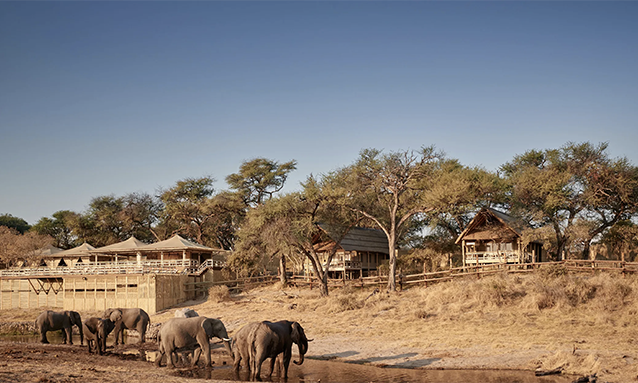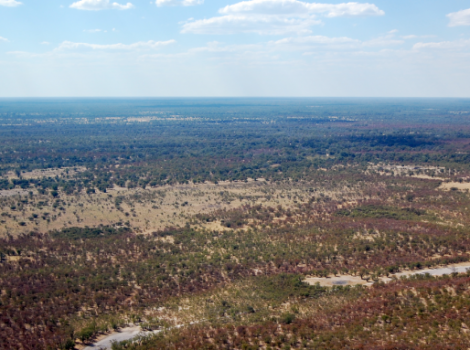
What to see, do, and where to stay when you’re planning the ultimate escape
Not many places in Africa still feel completely wild, which accounts for Botswana’s ongoing allure as an exceptional safari destination. Regarded as one of Africa’s most expensive game-viewing destinations, Botswana represents the sharp edge of adventurous, transformative travel to pristine, remote places with a timeless appeal. All the best safari operators have a solid presence here, from AndBeyond and Wilderness to Great Plains Conservation and Natural Selection. In their shared mission to fund the conservation of wild places through sustainable, positive-impact travel, old camps in prime locations have been rebuilt to more exacting earth-friendly standards, while expedition-style camps and authentic mobile operations in increasingly far-flung concessions are all the rage – privacy and access to space being the ultimate luxuries.
Botswana’s main attraction is the Okavango Delta, a lush wilderness of grassy floodplains, islands and a complex network of water channels shaped by hippo and elephant activity in one of the most nutrient-rich ecosystems in the world. The Okavango Delta is known for exceptional wildlife viewing, unparalleled predator populations, and excellent birding, particularly in the breeding season.
Like walking, exploration by boat and mokoro (dug-out canoe) adds an exciting, more immersive dimension to game viewing. Further north, the private reserves of the Selinda, Kwando and Linyanti are vast wilderness areas with equally rich river systems.
With only a handful of stylish bush camps, guests enjoy exclusive access to all this space and prime game viewing. Enormous elephant herds are synonymous with the ever-popular Chobe National Park, which stretches from the Chobe River to the fringes of the Okavango in the south. In particular, the Savute marsh area offers some of Botswana’s most dramatic predator-prey interactions. The semi-desert Kalahari dominates most of Botswana and offers surprisingly diverse game viewing, from black-maned lions, brown hyenas and wild dogs to typically elusive species, like aardwolf, pangolin, wild cat, and meerkat. And then there is the other-worldly Makgadikgadi salt pans where arid savannah grasslands provide lush grazing for thousands of plains zebra during the green season. Interpretative walks with the Kalahari’s San people offer a fascinating insight into their traditional hunter-gatherer culture.

Where to go on a Botswana safari
Much of the Okavango Delta, a UNESCO World Heritage Site, is protected by the Moremi Game Reserve. Surrounding this are privately managed conservation concessions, many previously given to hunting. Granted by lease from local communities, expansion in these small concessions has been kept in check by strict environmental standards and visitor number restrictions. Many Insta-worthy, eco-luxe, sustainably run safari camps are located in this low-footprint, game-rich private concessions that benefit local communities.
A fine example is Natural Selection’s partnership with local, land-owning communities in the Khwai reserve, a 200,000-hectare privately protected area where proceeds from eco-friendly camps, like Sable Alley and Tuludi, are ploughed straight back into conservation and empowerment projects.
Unlike the national parks and reserves, private concessions offer the flexibility and freedom of guided walking safaris, night drives and off-roading for up-close animal sightings and photography. It is unusual to see vehicles on game drives other than those from the same camp. Many of the best camps are only accessible by air, a perfect opportunity to appreciate the delta’s patchwork of islands, floodplains, crystal-clear channels, and lagoons from above. Helicopter transfers between camps or into remote areas, like the Kweene Trails concession where Beagle Expeditions operates exclusive-use mobile camps, reveal the diversity and amount of wildlife from the air: pods of hippos, elephants feeding on the water’s edge, and fleet-footed red lechwe leaping through the shallows.
The Linyanti region, between the Okavango Delta, Chobe National Park and Namibia’s Caprivi Strip, has permanent rivers and sprawling floodplains supporting prolific wildlife, in particular hippos and crocodiles, big cats, large buffalo and elephant herds, and reliable wild dog sightings. Boat cruises and walks are also excellent for birding.
During the dry winter season, the Linyanti, Selinda and Kwando reserves really come into their own as safari destinations when animals migrate to the Linyanti wetlands from the woodlands and high concentrations of game are seen along the waterways.
The wide, open spaces of the semi-arid Kalahari and lunar-like Makgadikgadi salt flats offer a completely different perspective of the country after the lushness of the wetlands. The Bousfield family’s Jack’s Camp put the Makgadikgadi salt pans on the safari circuit. Marooned on a grassy island on the edge of 10,000 kilometres of salt flats, it remains the only safari operation for 160 kilometres. (100 miles). From combing the pans for fossils and elusive brown hyenas to sleeping under the stars on nearby Kubu Island, this is a place to be humbled by the deafening silence of such extraordinary vastness, broken only by the rustle of mokolwane palm leaves on the islands.
When to go on a Botswana safari
Given the popularity of Botswana’s small camps, ‘whenever you can get a booking’ is the best time to go. It also depends on what interests you and where you are going. The best time to visit the Okavango Delta is during the dry winter season from June to September when the delta floods and rising water levels attract animals from the dry interior. This is also the best time for water activities, like mokoro trips, boating and fishing. The water levels are usually at their highest in August, promising excellent game viewing along the waterways.
Nothing beats being in Botswana when the life-giving first rains arrive in November, triggering the calving season for impala and other antelope species. For birders, the summer months offer the dual attraction of resident and migratory birds. Elsewhere, to witness dramatic predator-prey encounters, the dry months are also considered prime as animals are concentrated at water sources. Wildlife disperses during the rainy summer months, from January to April, and can be trickier to find. The best time to visit Chobe National Park is between June and October, when enormous elephant herds congregate on the riverbanks.
The Makgadikgadi experiences dramatic seasonal changes, which dictate activities. The dry winter season is for zooming across the salt pans on fat bikes or quads, hanging out with habituated meerkats and camping out under the stars; summer’s lush grasses are a magnet for thousands of migrating zebras and flamingoes.
Where to stay on a Botswana Safari
Sandibe Okavango Safari Lodge, Chitabe Concession, Okavango Delta
This designer off-grid lodge is on the edge of game-rich Chief’s Island in the private Chitabe concession. Twelve guest suites, clad in timber to resemble weaver’s nests, hang like giant baskets in the tree canopy, creating a sense of being cocooned in nature. During the day, iridescent dragonflies and jewel-bright birds dart in and out of the reed-filled Sandibe River in front of the camp while grunting hippos and a chorus of painted reed frogs lull you to sleep at night. Twice-daily game drives are good for regular sightings of lion, cheetah, wild dog, red lechwe and elephant.
Best for: Giddily romantic getaways for two include taking a plunge in your private pool after dark while fireflies flash in and out of the reeds and a hyena yelps somewhere out there in the wilderness. Luxurious sheets feel much more decadent in pared-down interiors, not overwhelmed by gratuitous detail. andbeyond.com
Xigera Safari Lodge
The most ambitious African art collection ever commissioned – during lockdown, no less – is the USP of this glamorous safari camp, accessed by boat when the delta floods. Red Carnation’s Tollman family collaborated with Southern Guild, a contemporary design gallery in Cape Town, to commission 80 artists, artisans, crafters and designers across Africa to produce a living gallery in the Moremi Game Reserve.
It includes furniture sculpted on-site from fallen trees and bespoke crockery collections by some of the continent’s edgiest ceramicists. Design inspiration came from the natural surroundings, like the lily pad design of the bronze-cast shower floors. Menus tempt with lamb rogan josh, a nod to the Oyster Box in South Africa, but there is also plant-based wholesomeness. Despite its lavish footprint, the entire property is off-grid – the latest in Tesla solar-hybrid energy technology powers the staff village too.
Best for: Drift along in a glass-bottomed mokoro, then sleep in the triple-storey, an off-grid treehouse with an open-air rooftop bed. This star bed doubles as a monumental baobab sculpture. And don’t miss the shop for exquisite homeware and objects by Bronze Age, Chuma Maweni, Madoda Fani, and Stanislaw Trzebinksi, as well as African-made jewellery, clothing, bags, purses and linen. xigera.com
Jack’s Camp, Makgadikgadi
One of just three camps within a private 400,000-hectare wildlife reserve on the edge of the Makgadikgadi salt pans, the iconic Jack’s Camp has been reinvented for the next generation with the latest in Tesla-tech solar energy. While still paying homage to the much-loved 1940s campaign style embellished with rich fabrics worldwide, the nine dreamy 270-square-metre tents (two for families) now have private pools, wood-burning stoves, and indoor-outdoor showers. The beautiful pool pavilion is the spot for sinking into a stripy deck chair to admire the endless views.
Best for: Activities unique to the area. Head out after an English breakfast or decadent high tea to quad bike across the pans, walk with bushmen, track brown hyenas, or hang out with habituated meerkats. naturalselection.travel
Sable Alley
It’s all about location at this low-key camp. Twelve 55-square metre elevated tents overlook a tranquil lagoon filled with resident hippos in northern Botswana’s Khwai Private Reserve. Referred to in safari circles as a wildlife’ hot spot’, the reserve is located where the dry Chobe game reserve to the east meets the lush wetlands of the Moremi game reserve and the Okavango Delta in the south.
Eco-chic in design and ambience, two of the 12 tents are double tents for families, and a honeymoon suite has a private outdoor tub and shower. While herds of elephants and buffalo are easy to spot from the pool deck, access to over 200,000 hectares of floodplains, rivers and lagoons typical, and open savannah and woodland thickets is a reason to get up and get out early. Game viewing is as diverse as the landscapes, which means that sightings of leopard, lion, cheetah, the resident wild dog pack and sable antelope (after which the camp is named) are common. Birding is also excellent, especially on walks, mokoro rides or a sunset boat cruise. Book a night in one of three open-air ‘sky beds’ perched high above a waterhole where elephants, buffalo and big cats come to drink.
Best for: Travel to make a difference, as Natural Selection are experts in sustainable, nature-based tourism, partnering with local, land-owning communities in the Khwai private wildlife concession and channelling funds back into conservation. naturalselection.com
Source: https://www.cntraveller.com/article/botswana-safari



